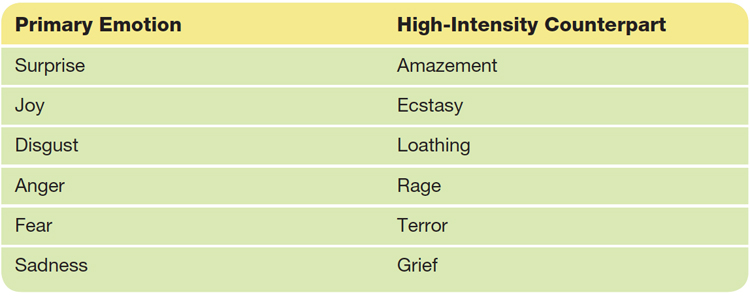4.1.3 Types of Emotions
Printed Page 115
Types of Emotions
Take a moment and look at the emotions communicated by the people in the photos below. How can you discern the emotion expressed in each picture? One way to distinguish between different types of emotions is to examine consistent patterns of facial expressions, hand gestures, and body postures that characterize specific emotions. By considering these patterns, scholars have identified six emotions they consider primary emotions—emotions that involve unique and consistent behavioral displays across cultures (Ekman, 1972). The six primary emotions are surprise, joy, disgust, anger, fear, and sadness.

Some situations, like receiving an unexpected gift from a romantic partner or experiencing the death of a close relative, provoke especially intense primary emotions. In such cases, we often use different words to describe the emotion, even though what we’re experiencing is simply a more intense version of the same primary emotion (Plutchik, 1980). For instance, receiving a gift from a romantic partner may cause intense joy that we think of as “ecstasy,” just as the passing of a close relative likely will trigger intense sadness that we label as “grief” (see Table 4.2).
Table 4.2 Intense Primary Emotions

In other situations, an event may trigger two or more primary emotions simultaneously, resulting in an experience known as blended emotions (Plutchik, 1993). For example, imagine that you’re borrowing your romantic partner’s computer when a “new message” e-mail alert pops up. Giving in to temptation, you click to the message, only to read, “Thinking of you constantly since our night together. Can’t wait to see you this weekend!” What emotion do you experience at that moment? Many people in this situation would experience jealousy, a blended emotion because it combines the primary emotions anger, fear, and sadness (Guerrero & Andersen, 1998): in this case, anger at your partner, fear that your relationship may be threatened, and sadness at the thought of potentially losing your partner to a rival. Other examples of blended emotions include contempt (anger and disgust), remorse (disgust and sadness), and awe (surprise and fear) (Plutchik, 1993).
Blended Emotions
Watch this clip to answer the questions below.

Question
Want to see more? Check out the Related Content section for additional clips on emotional contagion.
While North Americans often identify six primary emotions—surprise, joy, love, anger, fear, and sadness (Shaver, Wu, & Schwartz, 1992)—some cultural variation exists. For example, in traditional Chinese culture, shame and sad love (an emotion concerning attachment to former lovers) are primary emotions. Traditional Hindu philosophy suggests nine primary emotions: sexual passion, amusement, sorrow, anger, fear, perseverance, disgust, wonder, and serenity (Shweder, 1993).